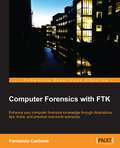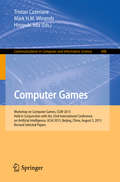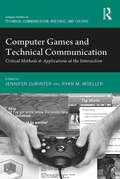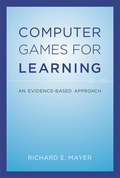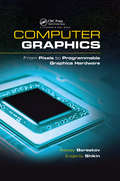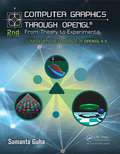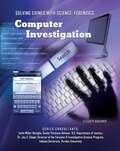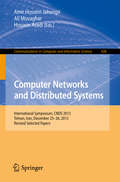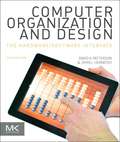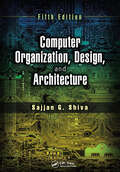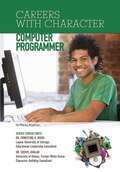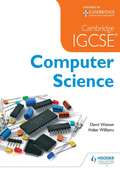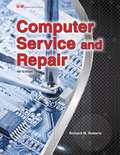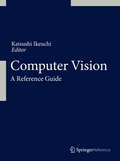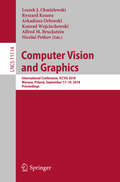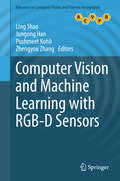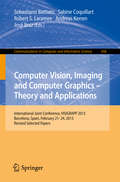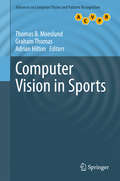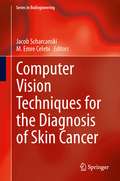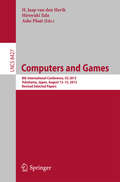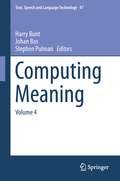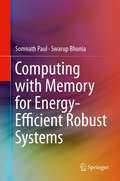- Table View
- List View
Computer Forensics with FTK
by Fernando CarboneThis tutorial contains detailed instructions with useful integrated examples that help you understand the main features of FTK and how you can use it to analyze evidence. This book has clear and concise guidance in an easily accessible format. This tutorial-based guide is great for you if you want to conduct digital investigations with an integrated platform. Whether you are new to Computer Forensics or have some experience, this book will help you get started with FTK so you can analyze evidence effectively and efficiently. If you are a law enforcement official, corporate security, or IT professional who needs to evaluate the evidentiary value of digital evidence, then this book is ideal for you.
Computer Games: Workshop on Computer Games, CGW 2013, Held in Conjunction with the 23rd International Conference on Artificial Intelligence, IJCAI 2013, Beijing, China, August 3, 2013, Revised Selected Papers (Communications in Computer and Information Science #408)
by Tristan Cazenave Mark H.M. Winands Hiroyuki IidaThis book constitutes the refereed proceedings of the Computer Games Workshop, CGW 2013, held in Beijing, China, in August 2013, in conjunction with the Twenty-third International Conference on Artificial Intelligence, IJCAI 2013. The 9 revised full papers presented were carefully reviewed and selected from 15 submissions. The papers cover a wide range of topics related to computer games. They discuss six games that are played by humans in practice: Chess, Domineering, Chinese Checkers, Go, Goofspiel, and Tzaar. Moreover, there are papers about the Sliding Tile Puzzle, an application, namely, Cooperative Path-Finding Problems, and on general game playing.
Computer Games and Technical Communication: Critical Methods and Applications at the Intersection (Routledge Studies in Technical Communication, Rhetoric, and Culture)
by Jennifer deWinter Ryan M. MoellerTaking as its point of departure the fundamental observation that games are both technical and symbolic, this collection investigates the multiple intersections between the study of computer games and the discipline of technical and professional writing. Divided into five parts, Computer Games and Technical Communication engages with questions related to workplace communities and gamic simulations; industry documentation; manuals, gameplay, and ethics; training, testing, and number crunching; and the work of games and gamifying work. In that computer games rely on a complex combination of written, verbal, visual, algorithmic, audio, and kinesthetic means to convey information, technical and professional writing scholars are uniquely poised to investigate the intersection between the technical and symbolic aspects of the computer game complex. The contributors to this volume bring to bear the analytic tools of the field to interpret the roles of communication, production, and consumption in this increasingly ubiquitous technical and symbolic medium.
Computer Games for Learning: An Evidence-Based Approach (The\mit Press Ser.)
by Richard E. MayerA comprehensive and up-to-date investigation of what research shows about the educational value of computer games for learning. Many strong claims are made for the educational value of computer games, but there is a need for systematic examination of the research evidence that might support such claims. This book fills that need by providing, a comprehensive and up-to-date investigation of what research shows about learning with computer games. Computer Games for Learning describes three genres of game research: the value-added approach, which compares the learning outcomes of students who learn with a base version of a game to those of students who learn with the base version plus an additional feature; the cognitive consequences approach, which compares learning outcomes of students who play an off-the-shelf computer game for extended periods to those of students who do not; and the media comparative approach, which compares the learning outcomes of students who learn material by playing a game to those of students who learn the same material using conventional media. After introductory chapters that describe the rationale and goals of learning game research as well as the relevance of cognitive science to learning with games, the book offers examples of research in all three genres conducted by the author and his colleagues at the University of California, Santa Barbara; meta-analyses of published research; and suggestions for future research in the field. The book is essential reading for researchers and students of educational games, instructional designers, learning-game developers, and anyone who wants to know what the research has to say about the educational effectiveness of computer games.
Computer Graphics: From Pixels to Programmable Graphics Hardware (Chapman And Hall/crc Computer Graphics, Geometric Modeling, And Animation Ser. #3)
by Alexey Boreskov Evgeniy ShikinComplete Coverage of the Current Practice of Computer GraphicsComputer Graphics: From Pixels to Programmable Graphics Hardware explores all major areas of modern computer graphics, starting from basic mathematics and algorithms and concluding with OpenGL and real-time graphics. It gives students a firm foundation in today's high-performance graphic
Computer Graphics Through OpenGL: From Theory to Experiments
by Sumanta GuhaFrom geometric primitives to animation to 3D modeling to lighting, shading, and texturing, Computer Graphics Through OpenGL: From Theory to Experiments, Second Edition presents a comprehensive introduction to computer graphics that uses an active learning style to teach key concepts. Equally emphasizing theory and practice, the book provides an und
Computer Investigation (Solving Crimes With Science: Forensics #12)
by Elizabeth BauchnerThe digital age we entered in the twenty-first century has rapidly become an age of digital crime. Cybercrimes like spoofing, phishing, and hacking are on the rise, and computer forensic technicians are on the case. Even "traditional" crimes like murder, fraud, and child abuse can be both facilitated by computers--and solved through computer investigation. Computer Investigation helps readers understand how cybercrimes are committed, and how investigators help solve them and bring the perpetrators to justice. Readers will also gain a few tips for protecting themselves online and protecting their computers from intrusions and hacks.
Computer Networks and Distributed Systems: International Symposium, CNDS 2013, Tehran, Iran, December 25-26, 2013, Revised Selected Papers (Communications in Computer and Information Science #428)
by Amir Hossein Jahangir Ali Movaghar Hossein AsadiThis book constitutes the refereed proceedings of the International Symposium on Computer Networks and Distributed Systems, CNDS 2013, held in Tehran, Iran, in December 2013. The 14 full papers presented were carefully reviewed and selected from numerous submissions. They are organized in topical sections such as cognitive and multimedia networks; wireless sensor networks; security; clouds and grids.
Computer Organization and Design: The Hardware/Software Interface (Fifth Edition)
by David A. Patterson John L. HennessyComputer Organization and Design, Fifth Edition, is the latest update to the classic introduction to computer organization. The text now contains new examples and material highlighting the emergence of mobile computing and the cloud. It explores this generational change with updated content featuring tablet computers, cloud infrastructure, and the ARM (mobile computing devices) and x86 (cloud computing) architectures. The book uses a MIPS processor core to present the fundamentals of hardware technologies, assembly language, computer arithmetic, pipelining, memory hierarchies and I/O. Because an understanding of modern hardware is essential to achieving good performance and energy efficiency, this edition adds a new concrete example, Going Faster, used throughout the text to demonstrate extremely effective optimization techniques. There is also a new discussion of the Eight Great Ideas of computer architecture. Parallelism is examined in depth with examples and content highlighting parallel hardware and software topics. The book features the Intel Core i7, ARM Cortex-A8 and NVIDIA Fermi GPU as real-world examples, along with a full set of updated and improved exercises. This new edition is an ideal resource for professional digital system designers, programmers, application developers, and system software developers. It will also be of interest to undergraduate students in Computer Science, Computer Engineering and Electrical Engineering courses in Computer Organization, Computer Design, ranging from Sophomore required courses to Senior Electives.
Computer Organization, Design, and Architecture, Fifth Edition
by Sajjan G. ShivaSuitable for a one- or two-semester undergraduate or beginning graduate course in computer science and computer engineering, Computer Organization, Design, and Architecture, Fifth Edition presents the operating principles, capabilities, and limitations of digital computers to enable development of complex yet efficient systems. With 50 percent updated material, 11 new sections, and four revised sections, this edition takes students through a solid, up-to-date exploration of single- and multiple-processor systems, embedded architectures, and performance evaluation.
Computer Programmer (Careers With Character)
by Sherry BonniceFind out what it takes to be a computer programmer with character... Computer programmers work in: *The computer and data-processing industry; *Engineering; *Management; *Telecommunications; *Banks; *Hospitals; *Government; *Research laboratories; and *A host of other industries. In our modern world, the field of computer programming is constantly expanding. Employers are seeking programmers who are skilled and conscientious. That's why computer programmers need: Integrity to honor property rights, including copyrights and patents... Self-discipline to stick with long and detailed jobs... And respect for the privacy of others. Do you think you might have the skills, interests, and character you need to succeed in this career? Computer Programmer will help you decide.
Computer Science
by David Watson Helen WilliamsA student workbook to support the students throughout their Cambridge IGCSE Computer Science course, with plenty of extra practice questions and activities. It accompanies the Cambridge IGCSE Computer Science student text book, following the contents and chapter order.
Computer Service And Repair, 4th Edition
by Richard M. RobertsComputer Service and Repair is written for those who have no PC experience, as well as those technicians who have limited formal training. Written in an easy-to-understand format with hundreds of illustrations, Computer Service and Repair takes the reader from basic instruction to test preparation for the CompTIA A+ Certification exams. For those who want to learn computer networking, programming, administration, or any of the computer sciences, Computer Service and Repair is the perfect place to start.
Computer Studies Part 1 class 10 - GSTB
by Gujarat State Board of School TextbooksThe Gujarat State Secondary and Higher Secondary Education Board has prepared new syllabi based on the open-source operating system and compatible open-source software tools for various topics of Computer Studies. These syllabi are sanctioned by the Government of Gujarat. The Part 1 of the textbook contains chapters 1 to 7.
Computer Studies Part 2 class 10 - GSTB
by Gujarat State Board of School TextbooksThe Gujarat State Secondary and Higher Secondary Education Board has prepared new syllabi based on the open-source operating system and compatible open-source software tools for various topics of Computer Studies. These syllabi are sanctioned by the Government of Gujarat. The Part 1 of the textbook contains chapters 8 to 16 and appendix 1 to 4.
Computer Vision: A Reference Guide
by Katsushi IkeuchiThis comprehensive reference provides easy access to relevant information on all aspects of Computer Vision. An A-Z format of over 240 entries offers a diverse range of topics for those seeking entry into any aspect within the broad field of Computer Vision. Over 200 Authors from both industry and academia contributed to this volume. Each entry includes synonyms, a definition and discussion of the topic, and a robust bibliography. Extensive cross-references to other entries support efficient, user-friendly searches for immediate access to relevant information Entries were peer-reviewed by a distinguished international advisory board, both scientifically and geographically diverse, ensuring balanced coverage. Over 3700 bibliographic references for further reading enable deeper exploration into any of the topics covered. The content of Computer Vision: A Reference Guide is expository and tutorial, making the book a practical resource for students who are considering entering the field, as well as professionals in other fields who need to access this vital information but may not have the time to work their way through an entire text on their topic of interest.
Computer Vision and Graphics: International Conference, Iccvg 2014, Warsaw, Poland, September 15-17, 2014, Proceedings (Lecture Notes in Computer Science #8671)
by Nicolai Petkov Alfred M. Bruckstein Konrad Wojciechowski Arkadiusz Orłowski Ryszard Kozera Leszek J. ChmielewskiThis book constitutes the refereed proceedings of the International Conference on Computer Vision and Graphics, ICCVG 2018, held in Warsaw, Poland, in September 2018. The 45 full papers were selected from 117 submissions. The contributions are thematically arranged as follows: computer graphics, image quality and graphic, user interfaces, object classification and features, 3D and stereo image processing, low-level and middle-level image processing, medical image analysis, motion analysis and tracking, security and protection, pattern recognition and new concepts in classification.
Computer Vision and Machine Learning with RGB-D Sensors (Advances in Computer Vision and Pattern Recognition)
by Ling Shao Pushmeet Kohli Jungong Han Zhengyou ZhangThis book presents an interdisciplinary selection of cutting-edge research on RGB-D based computer vision. Features: discusses the calibration of color and depth cameras, the reduction of noise on depth maps and methods for capturing human performance in 3D; reviews a selection of applications which use RGB-D information to reconstruct human figures, evaluate energy consumption and obtain accurate action classification; presents an approach for 3D object retrieval and for the reconstruction of gas flow from multiple Kinect cameras; describes an RGB-D computer vision system designed to assist the visually impaired and another for smart-environment sensing to assist elderly and disabled people; examines the effective features that characterize static hand poses and introduces a unified framework to enforce both temporal and spatial constraints for hand parsing; proposes a new classifier architecture for real-time hand pose recognition and a novel hand segmentation and gesture recognition system.
Computer Vision, Imaging and Computer Graphics: International Joint Conference, VISIGRAPP 2013, Barcelona, Spain, February 21-24, 2013, Revised Selected Papers (Communications in Computer and Information Science #458)
by Sebastiano Battiato, Sabine Coquillart, Robert S. Laramee, Andreas Kerren and José BrazThis book constitutes the refereed proceedings of the 8th International Conference, VISIGRAPP 2013 consisting of the Joint Conferences on Computer Vision (VISAPP), the International Conference on Computer Graphics, GRAPP 2013, and the International Conference on Information Visualization IVAPP 2013, held in Barcelona, Spain, in February 2013. The 15 revised full papers presented were carefully reviewed and selected from 445 submissions. The papers are organized in topical sections on theory and applications in computer vision, image analysis, computer graphics, and information visualization.
Computer Vision in Sports (Advances in Computer Vision and Pattern Recognition)
by Graham Thomas Thomas B. Moeslund Adrian HiltonThe first book of its kind devoted to this topic, this comprehensive text/reference presents state-of-the-art research and reviews current challenges in the application of computer vision to problems in sports. Opening with a detailed introduction to the use of computer vision across the entire life-cycle of a sports event, the text then progresses to examine cutting-edge techniques for tracking the ball, obtaining the whereabouts and pose of the players, and identifying the sport being played from video footage. The work concludes by investigating a selection of systems for the automatic analysis and classification of sports play. The insights provided by this pioneering collection will be of great interest to researchers and practitioners involved in computer vision, sports analysis and media production.
Computer Vision Techniques for the Diagnosis of Skin Cancer (Series in BioEngineering)
by M. Emre Celebi Jacob ScharcanskiThe goal of this volume is to summarize the state-of-the-art in the utilization of computer vision techniques in the diagnosis of skin cancer. Malignant melanoma is one of the most rapidly increasing cancers in the world. Early diagnosis is particularly important since melanoma can be cured with a simple excision if detected early. In recent years, dermoscopy has proved valuable in visualizing the morphological structures in pigmented lesions. However, it has also been shown that dermoscopy is difficult to learn and subjective. Newer technologies such as infrared imaging, multispectral imaging, and confocal microscopy, have recently come to the forefront in providing greater diagnostic accuracy. These imaging technologies presented in this book can serve as an adjunct to physicians and provide automated skin cancer screening. Although computerized techniques cannot as yet provide a definitive diagnosis, they can be used to improve biopsy decision-making as well as early melanoma detection, especially for patients with multiple atypical nevi.
Computers and Games: 8th International Conference, CG 2013, Yokohama, Japan, August 13-15, 2013, Revised Selected Papers (Lecture Notes in Computer Science #8427)
by Hiroyuki Iida Aske Plaat H. Jaap HerikThis book constitutes the thoroughly refereed post-conference proceedings of the 8th International Conference on Computers and Games, CG 2013, held in Yokohama, Japan, in August 2013, in conjunction with the 17th Computer and Games Tournament and the 20th World Computer-Chess Championship. The 21 papers presented were carefully reviewed and selected for inclusion in this book. They cover a wide range of topics which are grouped into five classes: Monte Carlo Tree Search and its enhancements; solving and searching; analysis of game characteristic; new approaches; and serious games.
Computing for Biologists
by Ran Libeskind-Hadas Eliot BushComputing is revolutionizing the practice of biology. This book, which assumes no prior computing experience, provides students with the tools to write their own Python programs and to understand fundamental concepts in computational biology and bioinformatics. Each major part of the book begins with a compelling biological question, followed by the algorithmic ideas and programming tools necessary to explore it: the origins of pathogenicity are examined using gene finding, the evolutionary history of sex determination systems is studied using sequence alignment, and the origin of modern humans is addressed using phylogenetic methods. In addition to providing general programming skills, this book explores the design of efficient algorithms, simulation, NP-hardness, and the maximum likelihood method, among other key concepts and methods. Easy-to-read and designed to equip students with the skills to write programs for solving a range of biological problems, the book is accompanied by numerous programming exercises, available at www. cs. hmc. edu/CFB.
Computing Meaning: Volume 4 (Text, Speech and Language Technology #47)
by Harry Bunt Johan Bos Stephen PulmanThis book is a collection of papers by leading researchers in computational semantics. It presents a state-of-the-art overview of recent and current research in computational semantics, including descriptions of new methods for constructing and improving resources for semantic computation, such as WordNet, VerbNet, and semantically annotated corpora. It also presents new statistical methods in semantic computation, such as the application of distributional semantics in the compositional calculation of sentence meanings. Computing the meaning of sentences, texts, and spoken or texted dialogue is the ultimate challenge in natural language processing, and the key to a wide range of exciting applications. The breadth and depth of coverage of this book makes it suitable as a reference and overview of the state of the field for researchers in Computational Linguistics, Semantics, Computer Science, Cognitive Science, and Artificial Intelligence.
Computing with Memory for Energy-Efficient Robust Systems
by Swarup Bhunia Somnath PaulThis book analyzes energy and reliability as major challenges faced by designers of computing frameworks in the nanometer technology regime. The authors describe the existing solutions to address these challenges and then reveal a new reconfigurable computing platform, which leverages high-density nanoscale memory for both data storage and computation to maximize the energy-efficiency and reliability. The energy and reliability benefits of this new paradigm are illustrated and the design challenges are discussed. Various hardware and software aspects of this exciting computing paradigm are described, particularly with respect to hardware-software co-designed frameworks, where the hardware unit can be reconfigured to mimic diverse application behavior. Finally, the energy-efficiency of the paradigm described is compared with other, well-known reconfigurable computing platforms.
